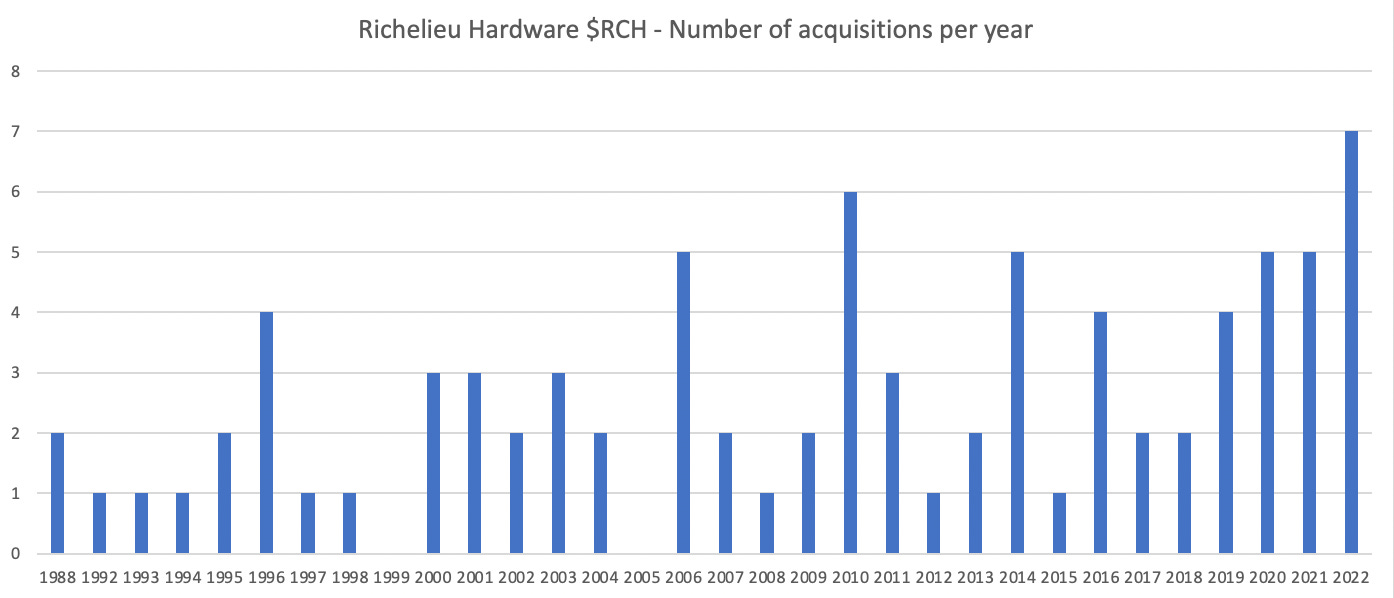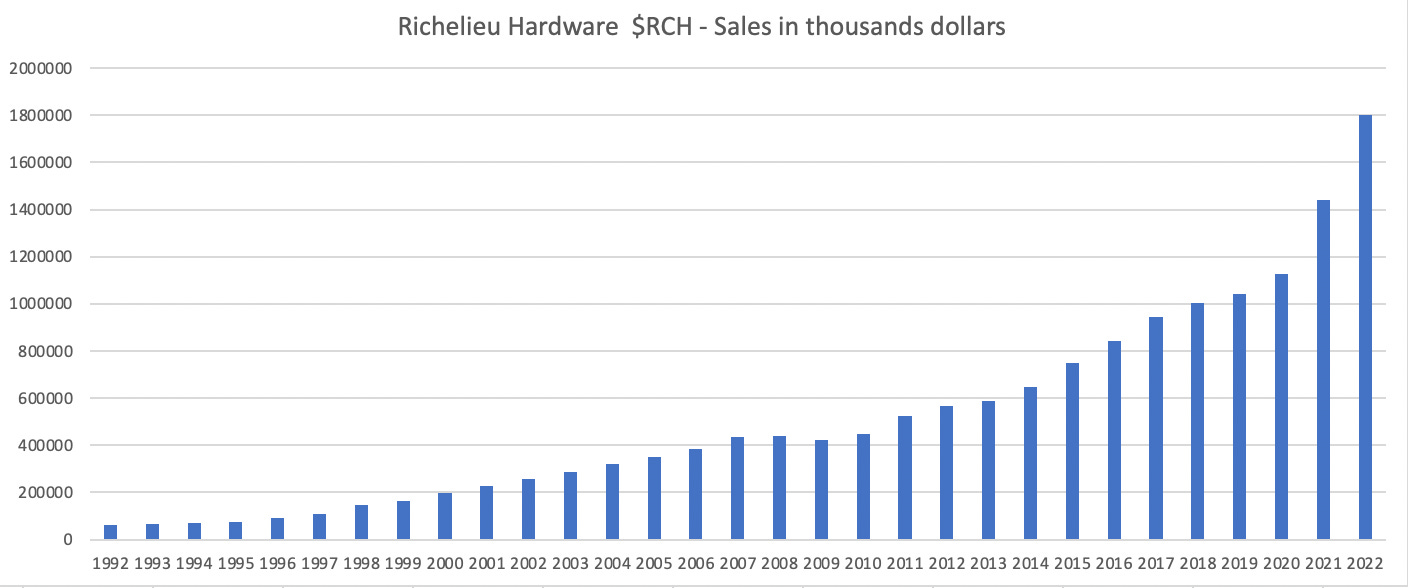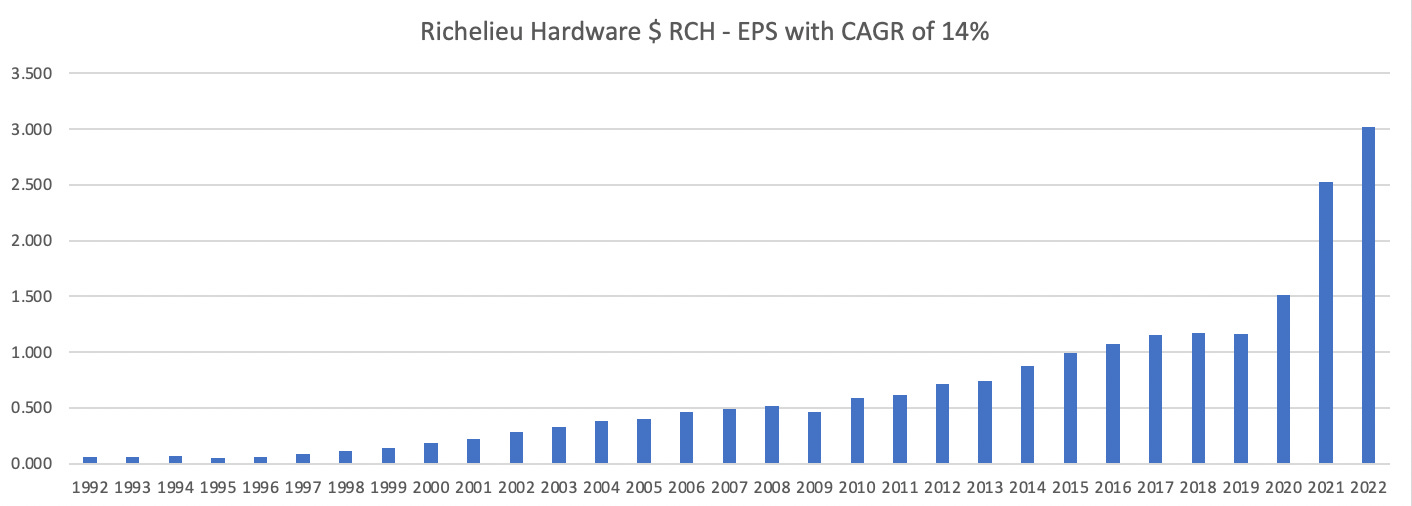PART1: Richelieu Hardware: Consolidator of a fragmented industry
Serial acquirer and North American's leading distributor, importer and manufacturer of speciality hardware (kitchen cabinet, furniture, door, etc.) is priced attractively at only 12 times earnings.
All figures in this article are in canadian dollars
The article constitutes my personal views and is for entertainment purposes only. This is not an investment advice. Please refer to the disclaimer at the end of this article for more details.
This post was published more than 2 months ago. After 2 months a public post is automatically archived. Only paid subscriber have full access to archived post. You can subscribe at 5$ per month to get access to archived.
Part 2 and Part 3 on Richelieu is also available
https://wintergems.substack.com/p/part2-richelieu-hardware-risk-factors
https://wintergems.substack.com/p/part-3-richelieu-hardware-valuation
Richard Lord, 32 years at the helm
In 1988, when Richard Lord became the new CEO, Richelieu hardware was a regional distributor of speciality hardwares with $28 million of sales and 2 warehouses in Montreal. This distributor, like hundreds of its peers, was operating in a very fragmented market in Canada, addressing the needs of local manufacturers of kitchen cabinets, woodworking entrepreneurs, furnitures makers.
Fast forward 16 years later circa 2004, Richelieu hardware was Canada’s leading distributor of speciality hardware with $302 million of sales, 28 warehouses in Canada and 8 warehouses in USA, after making 28 acquisitions of local and regional distributors in Canada while innovating and expanding organically its product offering.
In the 2004 annual report, here is how it viewed itself:
Richelieu Hardware Ltd. is Canada’s leading distributor, importer and manufacturer and of specialty hardware and complementary products. These products are targeted to an extensive customer base of kitchen cabinet, furniture, and window and door manufacturers plus the residential and commercial woodworking industry, as well as a large customer base of retailers, including hardware and renovation product superstores.
In 2004, Richelieu hardware made its first acquisition in US and started to significantly expand into the U.S. market using the same playbook, by acquiring local or regional distributor or building new warehouses across the country. At that time, the U.S. market represented only 9% of sales.
Fast forward another 16 years, in their latest results, Richelieu hardware had sales of $1802 million or 5 times sales of 2004, 112 centres (53 warehouses in Canada and 59 warehouses in U.S.), 84 cumulative acquisitions and 40% of sales from U.S.
Serial acquirer
Richelieu is a serial acquirer of local or regional distributors of speciality hardware having made 84 acquisitions in the last 32 years. Here is what the management had to say about their acquisition strategy in the 2018 annual report:
The highly fragmented market in which we operate provides us with diversified acquisition opportunities in our field. We take a patient and cautious approach that involves a rigorous research of suitable acquisition targets, which are consistent with our criteria of value creation and belief in our corporate culture. The acquisition strategy we have followed for over three decades is a major growth driver for Richelieu. It allows us to establish strong anchor points in new territories and strengthen our operations in markets where we already operate — while at the same time integrating expert local resources and new customers.
The following chart shows the number of acquisitions done by Richelieu hardware each year since 1988. As we can observe, since 1992, Richelieu did at least one acquisition each year except in 1999 and in 2005. In the last 4 years, the pace of acquistions has increased where Richelieu hardware is making at least 4 acquisitions per year.
Revenue Growth CAGR of 11.8%
In the last 30 years, Richelieu hardware has steadily grown revenue organically and through acquisitions at a CAGR of 11.8%.
The following chart illustrates the revenue line in thousand dollars since 1992.
The following chart shows the sales growth from previous year:
Growth is very predictable with only one down year since 1992 (during the Great Financial Crisis of 2009). If we exclude the -5% down year of 2009 and the 35% growth year of 1998, sales growth have ranged from 5% to 28%.
EPS growing at a CAGR of 14% since 1992
Earnings per share have grown even faster thanks to frequent buyback from the company with a CAGR of 14% since 1992.
Again, if we look at EPS growth from the previous year, growth is very steady with only 2 down year since 1992 (1995 and 2009). 1995 was a very though market in the construction business in Canada.
Products
Richelieu has 130 000 SKUs targeting the following categories: furniture, glass and building decorative and functional hardware, lighting systems, finishing and decorative products, ergonomic workstation components, kitchen and closet storage solutions, sliding door systems, decorative and functional panels, high pressure laminates, railing and baluster, floor protection products as well as hand tools and accessories for power tools.
Over the years, through innovation and acquisitions, the product offering has grown richer and richer. The following chart shows the number of total SKUs sold over the past 30 years:
Kitchen / Cabinets Solutions
Anything from the hinges inside a kitchen cabinets, to the pull, the knob, the door slider, fasteners, screws, drawer organization, kitchen sinks, bins, hoods, vacuum, and so on. You can check the link for more details:








